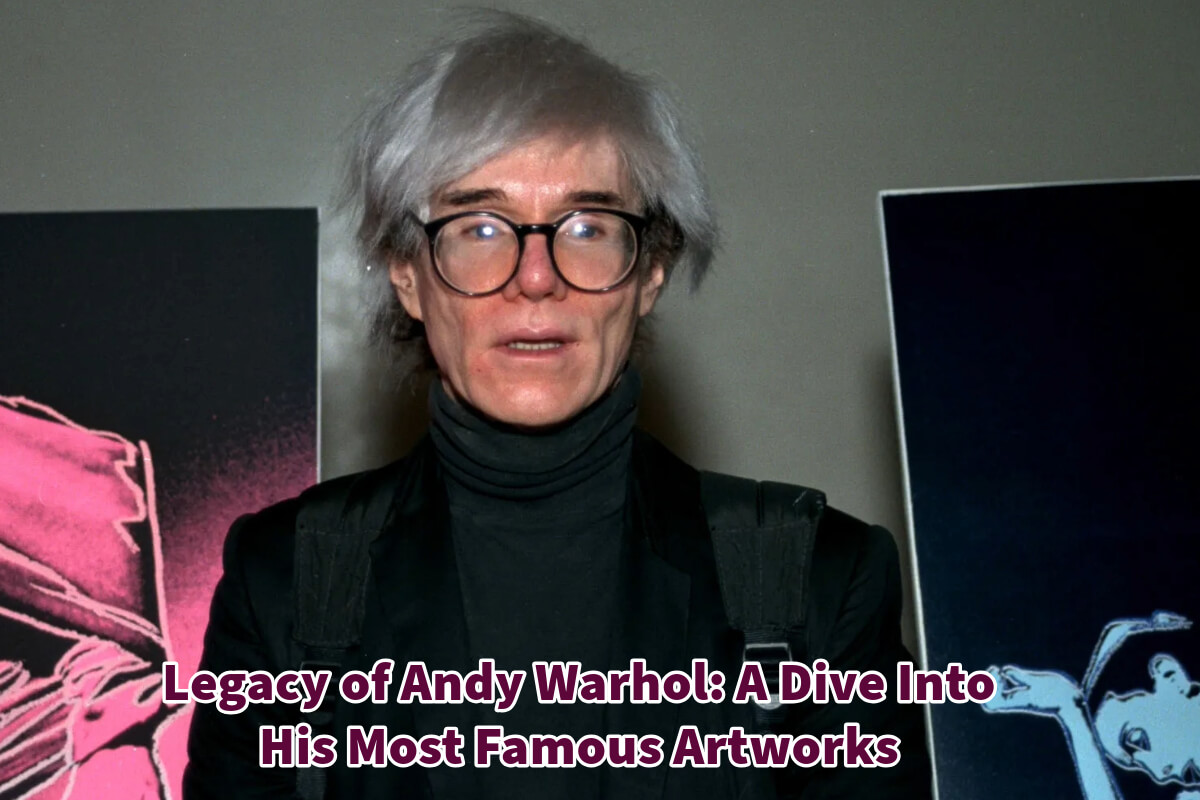Andy Warhol, a leading figure in the Pop Art movement, redefined the boundaries of art with his groundbreaking works that blurred the lines between high art and popular culture.
Andy Warhol’s oeuvre, characterized by bold colors, repetitive patterns, and a fascination with celebrity culture, continues to captivate audiences worldwide. Warhol’s innovative art-making approach and ability to reflect and critique contemporary society ensure his lasting legacy in the art world.
Table of Contents
- Andy Warhol: Redefining Art with Pop Culture
-
Andy Warhol’s Most Famous Works
- Campbell’s Soup Cans (1962)
- Marilyn Diptych (1962)
- Gold Marilyn Monroe (1962)
- Eight Elvises (1963)
- Silver Car Crash (Double Disaster) (1963)
- Liz #1 (Early Colored Liz) (1963)
- Brillo Boxes (1964)
- Flowers (1964)
- Jackie (1964)
- Self-Portrait (1966)
- Mao (1972)
- Skull (1976)
- The Last Supper (1986)
- Gun (1981)
- Shoes (1980)
-
Andy Warhol’s Most Famous Works
- Ten Reasons Why Andy Warhol Continues to Be a Popular American Artist
- Related Questions
Andy Warhol: Redefining Art with Pop Culture
Andy Warhol, a trailblazer in the Pop Art movement, revolutionized the art world with his innovative works that seamlessly merged high art with popular culture. Renowned for his use of bold colors, repetitive patterns, and a deep fascination with celebrity culture,
Warhol’s art continues to enthrall audiences globally. His unique approach to art-making, characterized by a blend of commercial and fine art elements, allowed him to reflect and critique contemporary society in a way that remains relevant today.
Read on as we delve into Warhol’s most iconic works, uncovering their significance, and explore the enduring impact of his artistic legacy.
Andy Warhol’s Most Famous Works
Andy Warhol produced many significant works of art. Here are 15 of his most iconic works.
Campbell’s Soup Cans (1962)

- Significance: This series of 32 canvases depicting a different flavor of Campbell’s soup is a seminal work in Pop Art. It challenges traditional notions of art by elevating a mundane commercial product to the status of fine art, questioning consumer culture and the nature of artistic value.
Marilyn Diptych (1962)
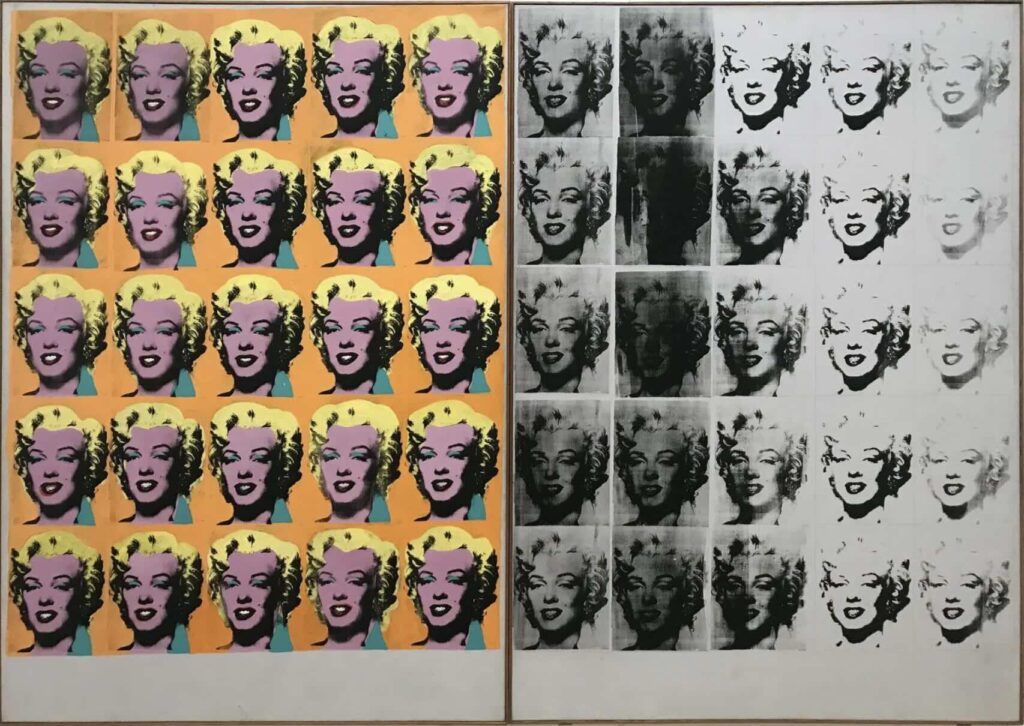
- Significance: This iconic work features 50 images of Marilyn Monroe, half in color and half in black and white, reflecting her glamour and the tragic aspects of her life. It explores themes of celebrity, mortality, and the mass reproduction of images.
Gold Marilyn Monroe (1962)

- Significance: Warhol’s use of gold background in this portrait of Marilyn Monroe echoes religious iconography, turning the actress into a modern-day saint or martyr, highlighting society’s idolization of celebrities.
Eight Elvises (1963)
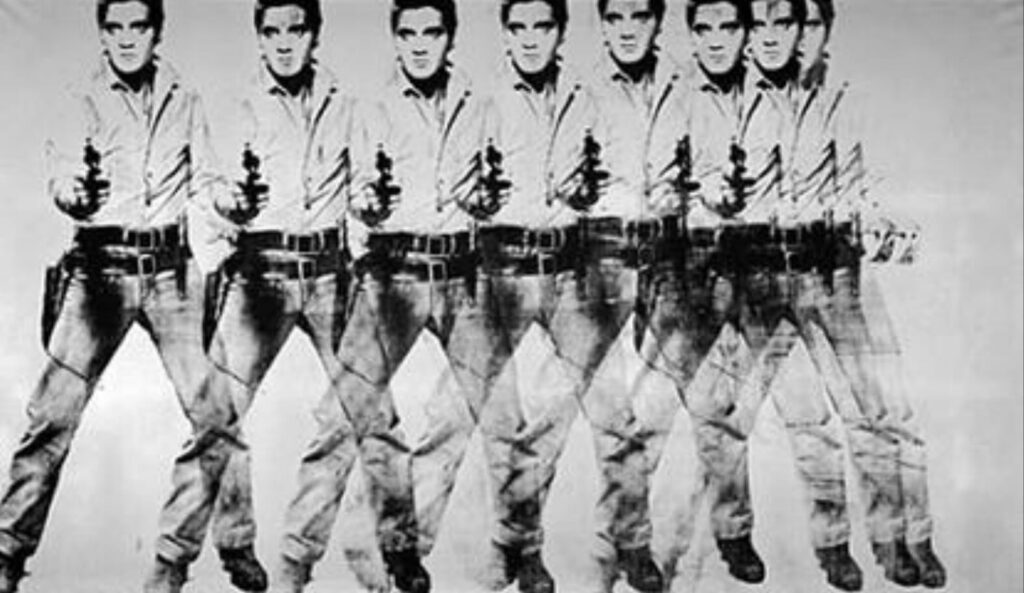
- Significance: Depicting Elvis Presley eight times in a single canvas, this work embodies Warhol’s fascination with fame and repetition. It’s also one of the most valuable artworks ever, emphasizing the commodification of celebrity culture.
Silver Car Crash (Double Disaster) (1963)

- Significance: Part of Warhol’s Death and Disaster series, this piece juxtaposes the glamour of silver with the grim reality of a car crash, exploring themes of mortality, media sensationalism, and desensitization to violence.
Liz #1 (Early Colored Liz) (1963)

- Significance: Featuring Elizabeth Taylor, this work underscores Warhol’s obsession with Hollywood icons and examines the interplay between celebrity image and personal identity.
Brillo Boxes (1964)

- Significance: By recreating commercial packaging as art, Warhol questioned the distinctions between art and commodity, challenging traditional views on what constitutes a work of art.
Flowers (1964)

- Significance: This series of vibrant floral images stands out for its departure from Warhol’s typical focus on consumer goods and celebrities. It demonstrates his versatility and the commercial appeal of even the most mundane subjects.
Jackie (1964)
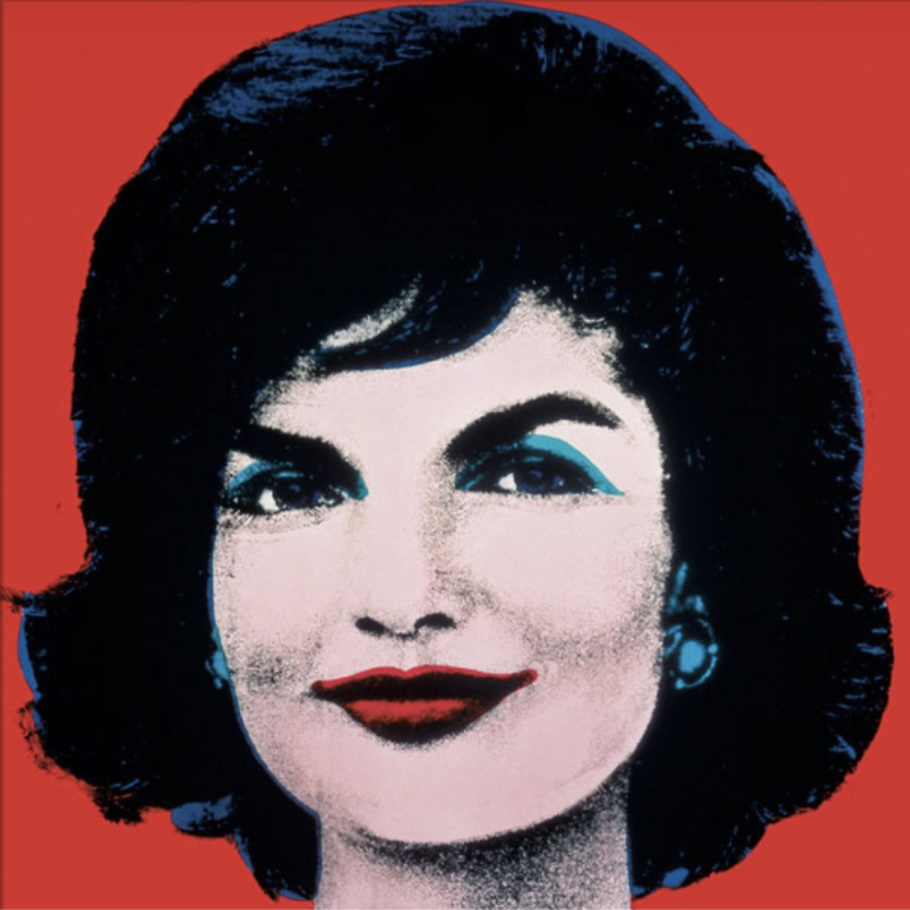
- Significance: This series of images depicting Jacqueline Kennedy during and after JFK’s assassination reflects Warhol’s exploration of grief, media representation, and the collective memory of tragic events.
Self-Portrait (1966)
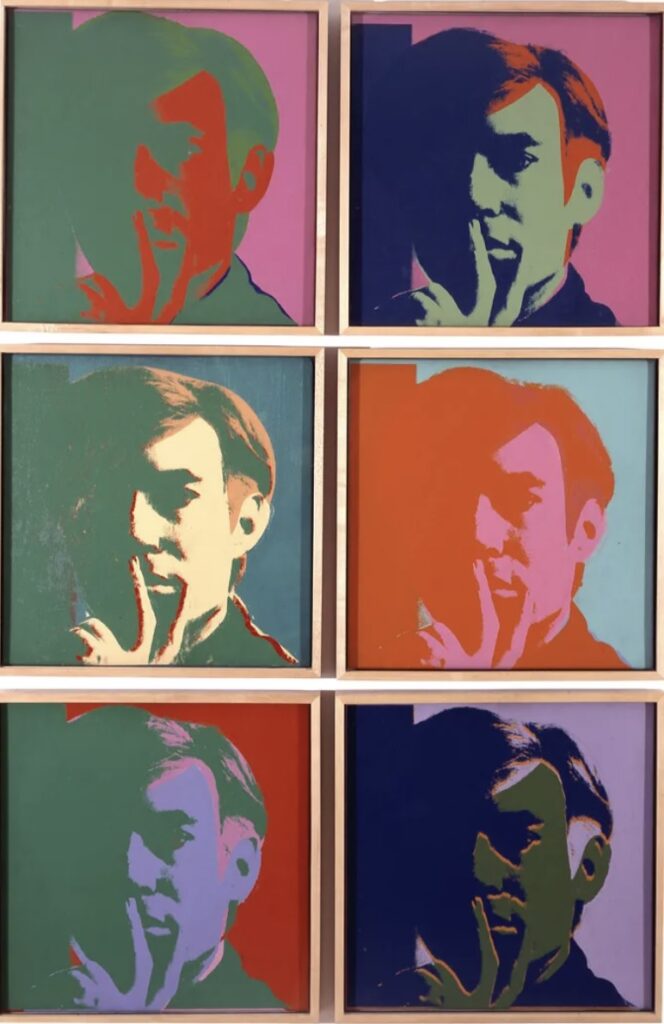
- Significance: Warhol’s self-portraits, with their eerie, spectral quality, delve into themes of identity, fame, and the elusive nature of the self, highlighting his persona as a constructed image.
Mao (1972)

- Significance: Warhol’s portraits of Mao Zedong blend political and pop culture, reflecting the power of mass media and the cult of personality surrounding political figures.
Skull (1976)

- Significance: This work is part of Warhol’s broader exploration of mortality. It juxtaposes vibrant colors with the macabre subject of a skull, blending themes of life, death, and the superficiality of appearances.
The Last Supper (1986)

- Significance: In one of his final works, Warhol reinterprets Leonardo da Vinci’s masterpiece, infusing it with contemporary commercial elements. He questions the commercialization of religious iconography and its impact on spiritual value.
Gun (1981)

- Significance: Warhol’s depiction of guns speaks to the prevalence of violence in American culture, using stark imagery to provoke thought on societal issues and the allure of danger.
Shoes (1980)

- Significance: This series emphasizes Warhol’s fascination with fashion and consumerism. It uses the repetitive image of shoes to explore themes of desire, identity, and the commercialization of everyday objects.
Ten Reasons Why Andy Warhol Continues to Be a Popular American Artist
There are many reasons why Andy Warhol is such an iconic artist. Here are some of the top 10 reasons why Andy Warhol continues to be such an iconic artist.
Innovative Approach:
Warhol’s use of everyday objects and commercial products as art subjects revolutionized the art world, making art accessible and relatable.
Cultural Reflection:
His works serve as a mirror to society, reflecting and critiquing contemporary culture, celebrity worship, and consumerism.
Versatility:
Warhol’s ability to work across various media—painting, film, photography, and sculpture—showcases his versatility and broadens his appeal.
Celebrity Focus:
Warhol’s fascination with fame and his portraits of iconic figures resonate with society’s ongoing obsession with celebrities.
Enduring Themes:
Themes of mortality, identity, and the commodification of culture in Warhol’s works remain relevant and continue to provoke thought and discussion.
Commercial Success:
Warhol’s art has achieved significant commercial success, with his works fetching high prices at auctions, underscoring their enduring value.
Pop Culture Icon:
Warhol himself became a cultural icon, his persona and statements about art and life contributing to his lasting legacy.
Artistic Influence:
Warhol’s influence on subsequent generations of artists is profound, inspiring countless creatives across various disciplines.
Museum and Gallery Presence:
His works are displayed in major museums and galleries worldwide, ensuring ongoing visibility and influence.
Public Engagement:
The continued interest in Warhol’s life and work, through exhibitions, documentaries, and academic studies, keeps his legacy alive and relevant in the public imagination.
Andy Warhol’s art, with its bold examination of modern life and culture, remains a cornerstone of contemporary art. His innovative techniques, profound themes, and unique perspective on society continue to captivate and inspire, ensuring his place as a timeless figure in the American art landscape.
Listen To Our Podcast About
What Makes Grant Wood’s American Gothic So Iconic?
Below or By clicking here.

Anita Louise Art is dedicated to art education, great artists, and inspiring others to find and create their art. We love art that uplifts and inspires. #ArtToMakeYouSmile! #ArtToMakeYouHappy!
If you want to see any of my art, you can find out more by clicking here. If you are interested in what inspires me and my paintings, you can discover more by clicking here.
We have a free newsletter and would love you to be part of our community; you can subscribe to the newsletter by clicking here. I would be happy to talk to you if you have any questions. You can reach me, Anita, by clicking here.
Subscribe to our Anita Louise Art YouTube Channel with great videos and information by clicking here.
Join us for our podcast “5 Minutes With Art.” Spend 5 minutes a week with us to discover and learn about great art and artists. You can find out more about our podcast by clicking here.
Related Questions
Andy Warhol’s Obsession With For Marilyn Monroe
Marilyn Monroe, a symbol of beauty, glamour, and tragedy, captivated the public during her all-too-brief life. And it was precisely this enigmatic combination of allure and vulnerability that seemed to magnetize Warhol. By repeatedly featuring Monroe in his art, he sought to unravel the layers of her celebrity status, exploring the blurred lines between reality and fiction and delving into the complexities of fame and its consequences.
By clicking here, you can learn more by reading Andy Warhol’s Obsession With For Marilyn Monroe.
Andy Warhol And The Pop Art Movement
Andy Warhol was expertly able to infuse consumer culture and popular media elements into his art; Warhol effectively blurred the line between high art and mass production. This ensured that he was a leading person in the Pop Art Movement.
You can discover more by reading Andy Warhol And The Pop Art Movement by clicking here.
Artist Andy Warhol – Everyone Will Be Famous 15 Minutes
In 1968, an acclaimed artist, and cultural visionary, Andy Warhol, made a bold statement that would prove prophetic: “In the future, everyone will be world-famous for 15 minutes.” Warhol could not have anticipated the transformative power of the digital age, where social media and personal branding have turned his prediction into a reality. Even today, there is controversy about whether he even said the quote.
You can learn more by reading Artist Andy Warhol – Everyone Will Be Famous 15 Minutes by clicking here.

